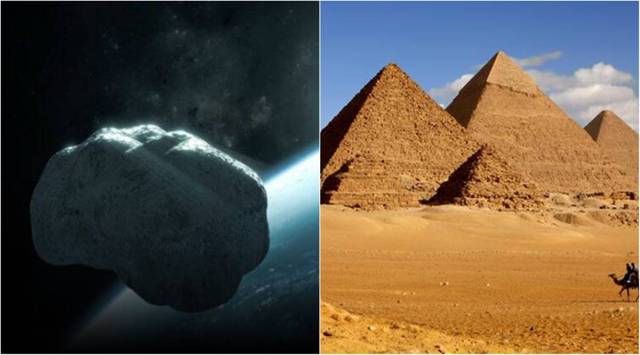- India
- International
Asteroid double the size of Pyramid Giza to enter Earth’s orbit on September 6
The massive asteroid has been classified as an Apollo asteroid because it crosses Earth's orbit. It was first spotted by astronomers a decade ago and called 465824 (2010 FR).
 The asteroid is believed to be twice the size of Pyramids of Giza (Source: Representational Image/Getty)
The asteroid is believed to be twice the size of Pyramids of Giza (Source: Representational Image/Getty)National Aeronautics and Space Administration (NASA) has been tracking an asteroid which is twice as big as the iconic Egyptian monument, Pyramid of Giza. The gigantic celestial object is expected to enter Earth’s orbit at around 15:30 IST on September 6. As per the reports, the asteroid is up to 270 metre wide and 886 feet tall.
The massive asteroid has been classified as an Apollo asteroid because it crosses Earth’s orbit. It was first spotted by astronomers a decade ago and called 465824 (2010 FR).
However, scientists at the Center for Near-Earth Object Studies (CNEOS) confirmed that like many asteroids that have been spotted to fly by our planet of late, it won’t be a threat.
According to NASA, a NEO is a term used to describe “comets and asteroids that have been nudged by the gravitational attraction of nearby planets into orbits that allow them to enter the Earth’s neighbourhood”.
The asteroid in question is a NEO as well as it is within 1.3 astronomical units from the Sun (1au = 14,95,97,871 kilometres).

ALSO READ | Two large asteroids to make close approach to Earth today
Even though asteroids like these are harmless because of their distance from Earth, they can come closer than expected due to the gravitational pull of other planets which can result in a change in the trajectory of their orbit. Not only this, but the Yarkovsky effect can also nudge an asteroid orbit. The change in orbit takes place when an asteroid absorbs sunlight and then re-emits that energy as heat or radiation.
ALSO READ | Hubble Telescope captures spellbinding image of supernova blast
“Occasionally, asteroids’ orbital paths are influenced by the gravitational tug of planets, which cause their paths to alter. Scientists believe stray asteroids or fragments from earlier collisions have slammed into Earth in the past, playing a major role in the evolution of our planet,” NASA said.
Also, On September 1, asteroid 2011 ES4 will be closer to our planet than the Moon. The estimated distance of the asteroid from Earth is 1.2 lakh km. Another asteroid named 2020 QG5 is approaching Earth again after 16 years on the same day. Both these asteroids won’t be a threat to our planet as well because of the distance and its small size which will be destroyed upon entering Earth’s atmosphere.
Express Tech is now on Telegram. Click here to join our channel (@expresstechie) and stay updated with the latest tech news.
More Tech
Apr 26: Latest News
- 01
- 02
- 03
- 04
- 05

































